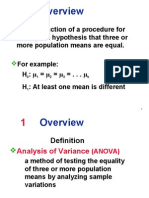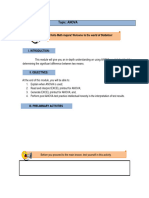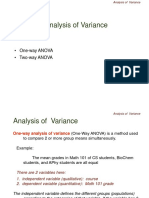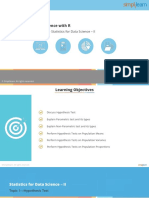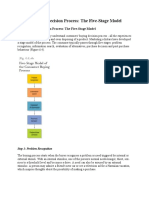1-Way Completely Randomized ANOVA: James H. Steiger
1-Way Completely Randomized ANOVA: James H. Steiger
Uploaded by
emirav2Copyright:
Available Formats
1-Way Completely Randomized ANOVA: James H. Steiger
1-Way Completely Randomized ANOVA: James H. Steiger
Uploaded by
emirav2Original Description:
Original Title
Copyright
Available Formats
Share this document
Did you find this document useful?
Is this content inappropriate?
Copyright:
Available Formats
1-Way Completely Randomized ANOVA: James H. Steiger
1-Way Completely Randomized ANOVA: James H. Steiger
Uploaded by
emirav2Copyright:
Available Formats
Introduction
An Introductory Example
The Basic Idea behind ANOVA
1-Way Completely Randomized ANOVA
James H. Steiger
Department of Psychology and Human Development
Vanderbilt University
James H. Steiger 1-Way Completely Randomized ANOVA
Introduction
An Introductory Example
The Basic Idea behind ANOVA
1-Way Completely Randomized Design
1 Introduction
2 An Introductory Example
3 The Basic Idea behind ANOVA
Calculation in R
James H. Steiger 1-Way Completely Randomized ANOVA
Introduction
An Introductory Example
The Basic Idea behind ANOVA
Introduction
In this module, we introduce the single-factor completely
randomized analysis of variance design.
We discover that there are several ways to conceptualize
the design.
For example, we can see the design as a generalization of
the 2-sample t-test on independent groups.
Or we can see it as a special case of a test for comparing
variances.
James H. Steiger 1-Way Completely Randomized ANOVA
Introduction
An Introductory Example
The Basic Idea behind ANOVA
An Introductory Example
Consider the following extremely simple, artificial data set
representing three groups, each with three subjects. The
scores are
Group1 Group2 Group3
1 1.00 4.00 7.00
2 2.00 5.00 8.00
3 3.00 6.00 9.00
James H. Steiger 1-Way Completely Randomized ANOVA
Introduction
An Introductory Example Calculation in R
The Basic Idea behind ANOVA
ANOVA:The Basic Idea
At its foundation, ANOVA attempts to assess whether a
group of means are all the same. If there are k groups, then
the null hypothesis might be written
H0 : µ1 = µ2 = . . . = µk (1)
James H. Steiger 1-Way Completely Randomized ANOVA
Introduction
An Introductory Example Calculation in R
The Basic Idea behind ANOVA
ANOVA:The Basic Idea
ANOVA does this by comparing the variability of the
sample means to what it should be if the population means
are all the same.
Suppose, for the time being, that the population means are
all the same, the sample sizes are all the same (n per
group), and the populations all have the same variance σ 2 .
Then the means represent repeated samples from the same
population.
In that case, as we recall from our earlier discussion of the
Z test, the variance of the sample means should be
approximately σM 2 = σ 2 /n.
It is crucial to realize that, under all the assumptions, that
is the smallest long run variance that these means can show
for any set of population mean values.
On the other hand, if the population means are not all the
same, then the variance of the sample means should be
larger than σ 2 /n, because the spread of the means reflects
more than sampling variability.
James H. Steiger 1-Way Completely Randomized ANOVA
Introduction
An Introductory Example Calculation in R
The Basic Idea behind ANOVA
ANOVA:The Basic Idea
The plot on the next side shows 10 sample means taken
from each of 3 groups. All populations had standard
deviations of 15 and sample sizes of 25. The lower line
shows 30 means from 3 populations with identical means of
100,100,100. Group 1 is red, Group 2 in blue, Group 3 in
green. The dispersion that you see along the line is totally
due to within group sampling variation.
The upper line shows 30 means sampled from populations
with means of 90,100,and 110. The dispersion of the means
on the top line reflects both within group sampling
variation and the spread of the means between groups.
James H. Steiger 1-Way Completely Randomized ANOVA
Introduction
An Introductory Example Calculation in R
The Basic Idea behind ANOVA
ANOVA:The Basic Idea
80 90 100 110 120
sample.mean
James H. Steiger 1-Way Completely Randomized ANOVA
Introduction
An Introductory Example Calculation in R
The Basic Idea behind ANOVA
ANOVA:The Basic Idea
As a consequence of the facts from the preceding slides, we
can conceptualize the null hypothesis in ANOVA in an
entirely different (but equivalent) way from Equation 1
To emphasize that this is a one-tailed hypothesis, I write
both the null and alternative hypotheses.
2 σ2 2 σ2
H0 : σM = H1 : σM > (2)
n n
James H. Steiger 1-Way Completely Randomized ANOVA
Introduction
An Introductory Example Calculation in R
The Basic Idea behind ANOVA
ANOVA:The Basic Idea
As a consequence of this, and a lot of statistical machinery,
we arrive at an F statistic that may be written, for k
groups,
s2 ns 2
Fk −1,k (n−1) = M = M (3)
σˆ2 /n σˆ2
We simply compute the sample variance of the sample
means, and divide by an estimate of σ 2 /n. With equal
sample sizes, σ̂ 2 is simply the mean of the group variances.
James H. Steiger 1-Way Completely Randomized ANOVA
Introduction
An Introductory Example Calculation in R
The Basic Idea behind ANOVA
ANOVA:The Basic Idea
Here are the calculations in R.
> Means <- c(mean(Group1),mean(Group2),mean(Group3))
> Variances <- c(var(Group1),var(Group2),var(Group3))
> n <- 3
> k <- 3
> MS.between <- n*var(Means)
> MS.within <- mean(Variances)
> F <- MS.between/MS.within
> df.between <- k-1
> df.within <- k * (n-1)
> c(MS.between,MS.within,F,df.between,df.within)
[1] 27 1 27 2 6
James H. Steiger 1-Way Completely Randomized ANOVA
Introduction
An Introductory Example Calculation in R
The Basic Idea behind ANOVA
Calculation in R
The preceding method of calculation is extraordinarily
simple. But it is only valid if each group has the same n.
The Gravetter-Walnau textbook gives computational
formulas for the analysis of variance in the general case
when n is not necessarily the same in each group. I also
provide computational instructions for the case of unequal
group n in a handout on the course website.
However, it is unlikely that, in practice, you will ever
calculate an ANOVA by hand. R makes it really easy.
First, have to enter your data in the correct, special format.
Instead of entering the data for our 3 groups in 3 columns,
we enter each score on a second line, accompanied by a
group code. The data entry process is shown on the next
slide.
James H. Steiger 1-Way Completely Randomized ANOVA
Introduction
An Introductory Example Calculation in R
The Basic Idea behind ANOVA
Calculation in R
It is vitally important that the factor variables are typed as
factors.
In this case, we are ready to go. The following simple
commands generate the ANOVA source table, as discussed
in your textbook.
> Group <- c(1,1,1,2,2,2,3,3,3)
> Score <- c(1,2,3,4,5,6,7,8,9)
> summary(aov(Score ~ factor(Group)))
Df Sum Sq Mean Sq F value Pr(>F)
factor(Group) 2 54 27 27 0.001 ***
Residuals 6 6 1
---
Signif. codes: 0 '***' 0.001 '**' 0.01 '*' 0.05 '.' 0.1 ' ' 1
The F statistic has a value of 27.00, with 2 and 6 degrees
of freedom.
Remember that this is a 1-tailed test, so the critical value
with α = 0.05 is at the 0.95 quantile. To find the critical
value, we use
> qf(0.95,2,6)
[1] 5.143253
James H. Steiger 1-Way Completely Randomized ANOVA
You might also like
- Essay AASDocument3 pagesEssay AASUttha75% (12)
- Chapter 5Document35 pagesChapter 5Linh Bảo BảoNo ratings yet
- Heaven and Hell - The Psychology of The Emotions (Ataraxia Book 3)Document191 pagesHeaven and Hell - The Psychology of The Emotions (Ataraxia Book 3)Sam Greene80% (5)
- Overcoming Shyness PDFDocument38 pagesOvercoming Shyness PDFChizzy David .ONo ratings yet
- Chi-Square and F DistributionsDocument52 pagesChi-Square and F DistributionsTalhaNo ratings yet
- ANOVA (F Test) UpdatedDocument36 pagesANOVA (F Test) UpdatedqueenbeeastNo ratings yet
- A Nova Sumner 2016Document23 pagesA Nova Sumner 2016Supun RandeniNo ratings yet
- ANALYSIS OF VARIANCEDocument11 pagesANALYSIS OF VARIANCEmusthafacv333No ratings yet
- ANOVADocument23 pagesANOVAAkash Raj BeheraNo ratings yet
- Biostatistics PPT - 5Document44 pagesBiostatistics PPT - 5asaduzzaman asadNo ratings yet
- Testing The AssumptionsDocument7 pagesTesting The Assumptionsestian.maritz1No ratings yet
- Analysis of Variance Basic Concepts: Yosni Bakar STAB 2004Document31 pagesAnalysis of Variance Basic Concepts: Yosni Bakar STAB 2004Shyama Sundari DeviNo ratings yet
- Chapter 6Document16 pagesChapter 6masud_me05No ratings yet
- ANOVA Study Guide and Practice ExamsDocument36 pagesANOVA Study Guide and Practice ExamspraveenNo ratings yet
- Anova-1Document27 pagesAnova-1Iftitah AkbarNo ratings yet
- AnovaDocument55 pagesAnovaFiona Fernandes67% (3)
- N o Va: Alysis F Riance (ANOVA)Document3 pagesN o Va: Alysis F Riance (ANOVA)masharabNo ratings yet
- An Ova 1Document21 pagesAn Ova 1LusiusNo ratings yet
- Mm13 Content Module 9Document12 pagesMm13 Content Module 9mrkpalmares0524No ratings yet
- PSY4051 - M3 - Introduction To ANOVADocument35 pagesPSY4051 - M3 - Introduction To ANOVAmailNo ratings yet
- A5 - One-Way ANOVADocument32 pagesA5 - One-Way ANOVAChristian Daniel100% (1)
- One Way AnovaDocument30 pagesOne Way AnovaAshwin VelNo ratings yet
- Balanced ANOVADocument40 pagesBalanced ANOVAGagana U KumarNo ratings yet
- PLU Quantitative Techniques 4Document13 pagesPLU Quantitative Techniques 4trintusdivalaNo ratings yet
- Anova - All AboutDocument18 pagesAnova - All AboutBrook Rene JohnsonNo ratings yet
- Anova Slides PresentationDocument29 pagesAnova Slides PresentationCarlos Samaniego100% (1)
- IMP Video ConceptDocument56 pagesIMP Video ConceptParthJain100% (1)
- 1-Day Training Workshop On Basic Statistics Techniques and Predictive Analysis (Module 2)Document85 pages1-Day Training Workshop On Basic Statistics Techniques and Predictive Analysis (Module 2)Rubylen D. MajaroconNo ratings yet
- 5 ASAP Advanced Statistics - ANOVA - TotalDocument127 pages5 ASAP Advanced Statistics - ANOVA - TotalGeorge MathewNo ratings yet
- Analysis of VarianceDocument6 pagesAnalysis of VarianceNkechi KokoNo ratings yet
- Analysis of Variance (Anova)Document15 pagesAnalysis of Variance (Anova)SrijanNo ratings yet
- Chapter 7 AnovaDocument20 pagesChapter 7 AnovaSolomonNo ratings yet
- ANo VADocument56 pagesANo VATeja Prakash chowdary100% (5)
- Applied Biostatistics 2020 - 05 ANOVADocument44 pagesApplied Biostatistics 2020 - 05 ANOVAYuki NoShinkuNo ratings yet
- Week 6 Lecture-1Document45 pagesWeek 6 Lecture-1dinehmetkariNo ratings yet
- An Ova 111Document4 pagesAn Ova 111Manish PrasadNo ratings yet
- T (Ea) For TwoDocument31 pagesT (Ea) For Twobszool006No ratings yet
- Anova NotesDocument7 pagesAnova NotesRaphael BalitaNo ratings yet
- Statistics: 1.5 Oneway Analysis of VarianceDocument5 pagesStatistics: 1.5 Oneway Analysis of Varianceأبوسوار هندسةNo ratings yet
- 13.1 Classroom NotesDocument4 pages13.1 Classroom NotesJohn DoeNo ratings yet
- Analysis of Variance: - One-Way ANOVA - Two-Way ANOVADocument36 pagesAnalysis of Variance: - One-Way ANOVA - Two-Way ANOVAc3353359No ratings yet
- One-Way ANOVADocument28 pagesOne-Way ANOVAvaskopax14No ratings yet
- 4.1analysis of Varianc Eand CovarianceDocument41 pages4.1analysis of Varianc Eand CovarianceminalNo ratings yet
- Analysis Analysis of Variance One Way AnovaDocument3 pagesAnalysis Analysis of Variance One Way AnovamaiNo ratings yet
- 6A-1 - ANOVA (F Test) UpdatedDocument36 pages6A-1 - ANOVA (F Test) UpdatedtzmjsnNo ratings yet
- Hypothesis Testing - Analysis of Variance (ANOVA)Document14 pagesHypothesis Testing - Analysis of Variance (ANOVA)Kumar RajNo ratings yet
- Introduction To Analysis of VarianceCDocument35 pagesIntroduction To Analysis of VarianceCyohannesNo ratings yet
- Numerical Example of OneDocument5 pagesNumerical Example of OneHarsh Raj NemaNo ratings yet
- Hypothesis Testing Using The One-Way Analysis of VarianceDocument52 pagesHypothesis Testing Using The One-Way Analysis of VarianceDrRam Singh KambojNo ratings yet
- Anova Training 6th DayDocument49 pagesAnova Training 6th Daysana mehmoodNo ratings yet
- Session 10Document10 pagesSession 10Osman Gani TalukderNo ratings yet
- Last Lecture 1Document17 pagesLast Lecture 1dinaelkordyNo ratings yet
- Chapter 5 Analysis of Difference Among Conditions Part 3Document41 pagesChapter 5 Analysis of Difference Among Conditions Part 3Nicole AgustinNo ratings yet
- Lesson 6 - Statistics For Data Science - IIDocument60 pagesLesson 6 - Statistics For Data Science - IIrimbrahimNo ratings yet
- Lec 8Document61 pagesLec 8dupsimugneNo ratings yet
- Data AnalysisDocument4 pagesData AnalysisLoey ParkNo ratings yet
- Completely Randomized DesignDocument5 pagesCompletely Randomized DesignQuinn's Yat100% (4)
- AnovaDocument40 pagesAnovaMary Loise SantosNo ratings yet
- AnovaDocument40 pagesAnovaBeenish MujahidNo ratings yet
- How to Find Inter-Groups Differences Using Spss/Excel/Web Tools in Common Experimental Designs: Book 1From EverandHow to Find Inter-Groups Differences Using Spss/Excel/Web Tools in Common Experimental Designs: Book 1No ratings yet
- Schaum's Easy Outline of Probability and Statistics, Revised EditionFrom EverandSchaum's Easy Outline of Probability and Statistics, Revised EditionNo ratings yet
- Mafv 2017 09Document2 pagesMafv 2017 09emirav2No ratings yet
- Mrs - Fidelity Asian Bond Fund Usd - Class 9: M1 - Medium Risk/returnDocument2 pagesMrs - Fidelity Asian Bond Fund Usd - Class 9: M1 - Medium Risk/returnemirav2No ratings yet
- Mrs - Fidelity Global Inflation-Linked Bond Fund Usd - Class 5Document2 pagesMrs - Fidelity Global Inflation-Linked Bond Fund Usd - Class 5emirav2No ratings yet
- 5 Ways Post BTFD 2018Document17 pages5 Ways Post BTFD 2018emirav2No ratings yet
- Range Break & Pullbacks: Trade Ideas ProfessionalsDocument19 pagesRange Break & Pullbacks: Trade Ideas Professionalsemirav20% (1)
- Solid Swing Trading Concepts Ebook PDFDocument16 pagesSolid Swing Trading Concepts Ebook PDFemirav2No ratings yet
- A Beginner's Guide To Getting Your First Data Science Job: 2019 EditionDocument63 pagesA Beginner's Guide To Getting Your First Data Science Job: 2019 Editionemirav2No ratings yet
- 6 Different Ways To Compensate For Missing Values in A Dataset (Data Imputation With Examples)Document10 pages6 Different Ways To Compensate For Missing Values in A Dataset (Data Imputation With Examples)emirav2No ratings yet
- Passive TradingDocument20 pagesPassive Tradingemirav233% (3)
- Deep Focus at WorkDocument56 pagesDeep Focus at Workemirav2No ratings yet
- Ret Deal StatusDocument4 pagesRet Deal Statusemirav2No ratings yet
- What Is HappinessDocument9 pagesWhat Is Happinessemirav2No ratings yet
- Electronic Trading 1.0: What'S NewDocument29 pagesElectronic Trading 1.0: What'S Newemirav2No ratings yet
- Data Science Crash Course - SharpSight PDFDocument107 pagesData Science Crash Course - SharpSight PDFemirav2100% (3)
- Event LoggerDocument6 pagesEvent Loggeremirav2No ratings yet
- Fundmarket Insight Report: Thomson Reuters Lipper Research SeriesDocument4 pagesFundmarket Insight Report: Thomson Reuters Lipper Research Seriesemirav2No ratings yet
- Hold Hold Hold Hold: Scorpio Tankers IncDocument5 pagesHold Hold Hold Hold: Scorpio Tankers Incemirav2No ratings yet
- The 67 Steps Program by Tai LopezDocument24 pagesThe 67 Steps Program by Tai Lopezmanishgrg@gmail50% (2)
- A Guide To Investing in Closed-End Funds: Key PointsDocument4 pagesA Guide To Investing in Closed-End Funds: Key Pointsemirav2No ratings yet
- Real Estate Investment TrustsDocument318 pagesReal Estate Investment Trustsemirav2100% (1)
- 6.2 The Buying Decision Process-The Five-Stage ModelDocument5 pages6.2 The Buying Decision Process-The Five-Stage ModelSanjeev JayaratnaNo ratings yet
- Exam 4 MGMT 301 - Study Guide QuestioDocument65 pagesExam 4 MGMT 301 - Study Guide QuestioNate PaulNo ratings yet
- Essential Question RubricDocument1 pageEssential Question Rubricapi-445513635No ratings yet
- 3 Great Greek Triumvirate in PhilosophyDocument23 pages3 Great Greek Triumvirate in PhilosophyPrecious CativoNo ratings yet
- De-Escalation TechniquesDocument2 pagesDe-Escalation Techniquesapi-452639774No ratings yet
- B2 First Sample Paper 2 ListeningDocument7 pagesB2 First Sample Paper 2 ListeningRamon Cipriano100% (1)
- I Learned 16-17Document2 pagesI Learned 16-17api-235065651No ratings yet
- Wicked Problem Signature Assignment 2Document9 pagesWicked Problem Signature Assignment 2api-516694258No ratings yet
- 1300 Math Formulas by Golden ArtDocument15 pages1300 Math Formulas by Golden ArtakremmelNo ratings yet
- BRM PresentationDocument16 pagesBRM PresentationKeshaw BhardwajNo ratings yet
- Toy LibraryDocument2 pagesToy LibraryRuquan PhuahNo ratings yet
- Presentation 6Document8 pagesPresentation 6Mukesh KundalNo ratings yet
- 2Document9 pages2olivia_le79No ratings yet
- The Effects of Bad Parenting On Children: Antisocial BehaviorDocument16 pagesThe Effects of Bad Parenting On Children: Antisocial BehaviorMinh TrịnhNo ratings yet
- English Language GlobalizationDocument6 pagesEnglish Language Globalizationmaruk26No ratings yet
- Multicultural Lesson PlanDocument6 pagesMulticultural Lesson Planapi-331853863No ratings yet
- Copy TestingDocument10 pagesCopy TestingArunjeet Singh RainuNo ratings yet
- Listening GamesDocument7 pagesListening Gamessmitha nairNo ratings yet
- ChakrasDocument35 pagesChakrasMahesh71% (14)
- Going FlatDocument4 pagesGoing FlatAnonymous QMabU3fhBNo ratings yet
- Q3 Wk4 M4 Lesson PlanDocument8 pagesQ3 Wk4 M4 Lesson PlanMC OntolanNo ratings yet
- Chiltern Edge School Prospectus 2014-15Document4 pagesChiltern Edge School Prospectus 2014-15BluegrasscomsNo ratings yet
- Maed 100Document3 pagesMaed 100christianNo ratings yet
- Types of Assesment Tools - ReportDocument27 pagesTypes of Assesment Tools - ReportEdel Villanueva100% (1)
- Identification Type Test Items: ExampleDocument5 pagesIdentification Type Test Items: Examplekarl100% (1)
- Final Reflective Essay Engl 120Document4 pagesFinal Reflective Essay Engl 120api-317672750No ratings yet


















